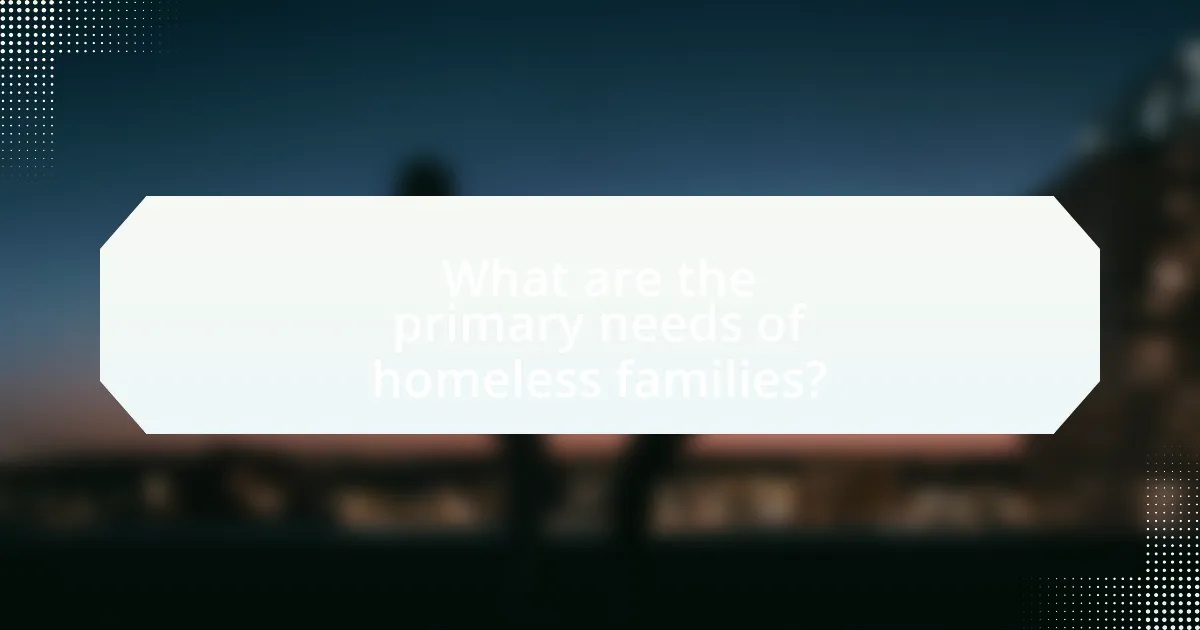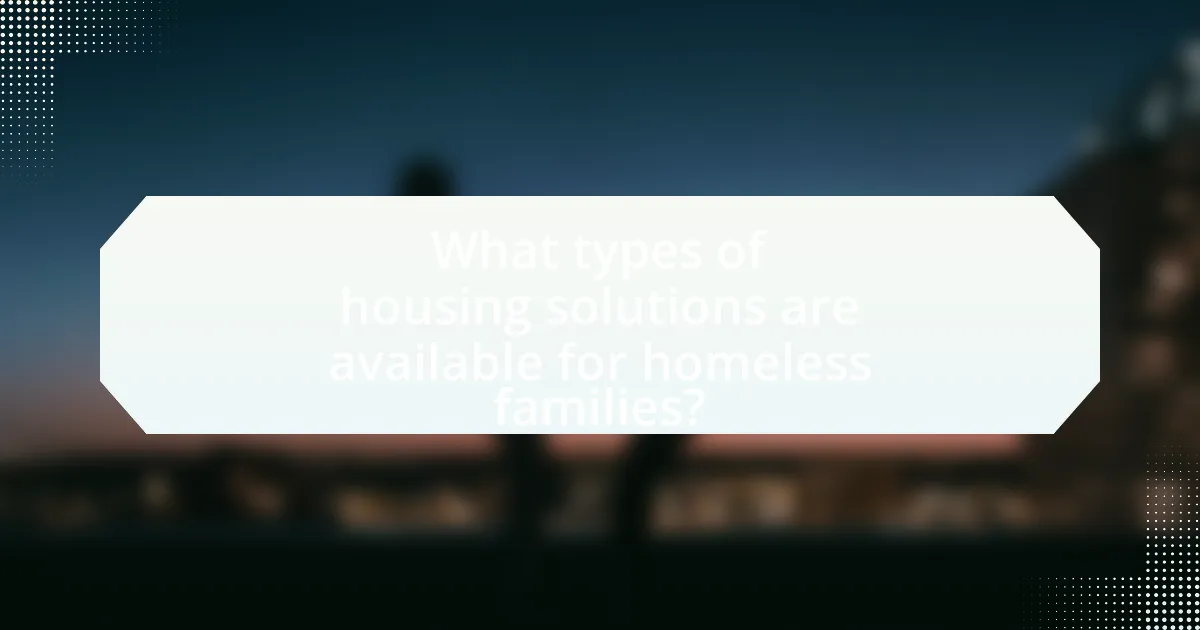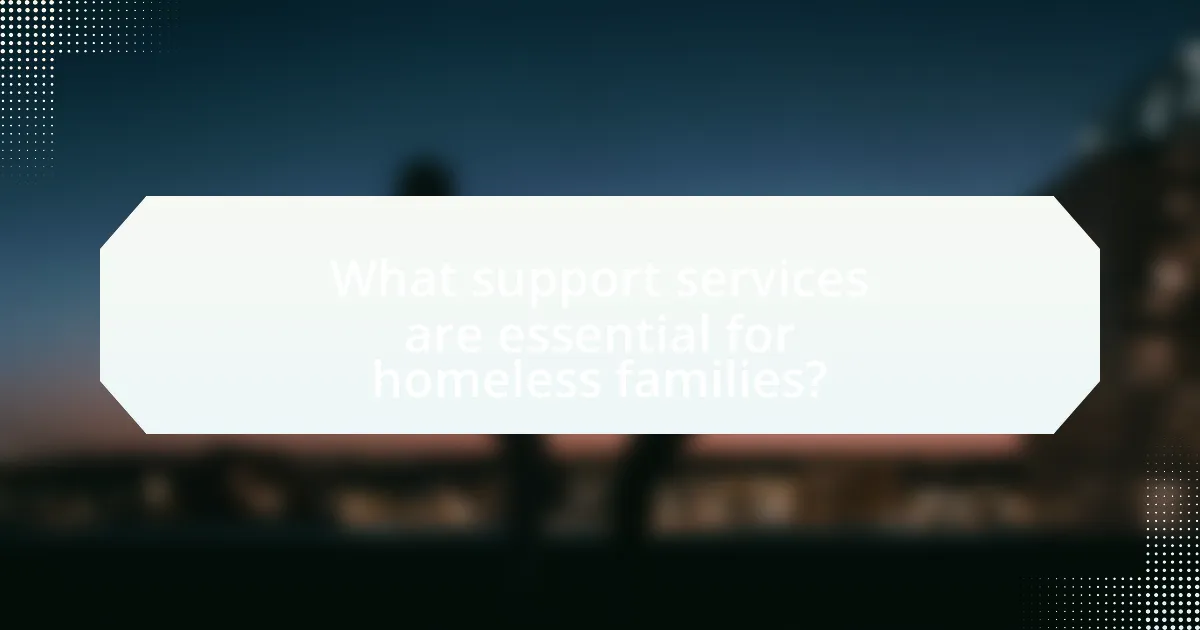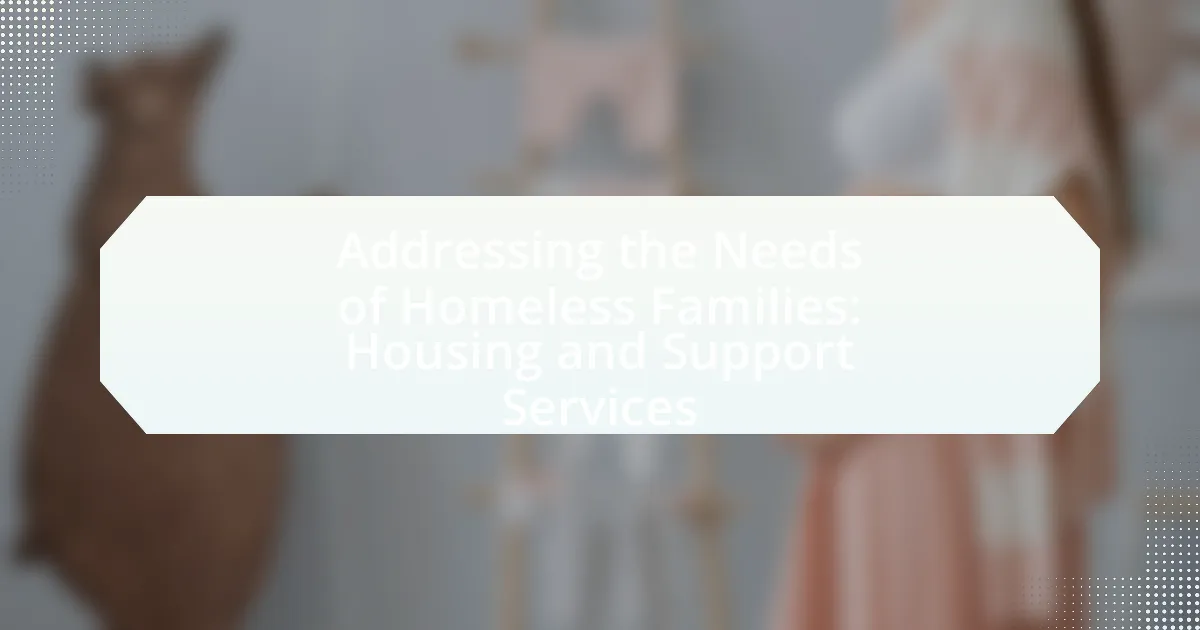The article focuses on the critical needs of homeless families, emphasizing the importance of stable housing, healthcare access, food security, and supportive services. It explores the impact of housing instability and lack of support on families, particularly regarding psychological effects and children’s education. The article also addresses barriers to accessing housing and support services, including financial constraints and discrimination. Various housing solutions, such as emergency shelters and permanent supportive housing, are discussed, along with the essential role of community organizations and case management in supporting homeless families. Finally, best practices and innovative approaches to improve services for these families are highlighted, underscoring the need for comprehensive and coordinated efforts to address family homelessness effectively.

What are the primary needs of homeless families?
The primary needs of homeless families include stable housing, access to healthcare, food security, and supportive services. Stable housing is essential as it provides a safe environment for families, which is crucial for their overall well-being and stability. Access to healthcare ensures that families can address medical needs, which is often compromised in homeless situations. Food security is vital for the health and development of children, as inadequate nutrition can lead to long-term health issues. Supportive services, such as job training and childcare, help families regain independence and improve their living conditions. According to the National Alliance to End Homelessness, addressing these needs is critical for breaking the cycle of homelessness and fostering long-term stability for families.
How do housing instability and lack of support services impact homeless families?
Housing instability and lack of support services severely impact homeless families by exacerbating their vulnerability and hindering their ability to achieve stability. Families facing housing instability often experience increased stress, which can lead to mental health issues and negatively affect children’s development. According to the National Alliance to End Homelessness, children in homeless families are more likely to face educational disruptions, health problems, and emotional challenges. The absence of support services, such as access to healthcare, job training, and counseling, further limits these families’ opportunities to secure stable housing and improve their overall well-being. Research indicates that families with access to comprehensive support services are more likely to transition out of homelessness successfully, highlighting the critical role these services play in mitigating the adverse effects of housing instability.
What are the psychological effects of homelessness on families?
The psychological effects of homelessness on families include increased anxiety, depression, and trauma. Families experiencing homelessness often face chronic stress due to instability, lack of resources, and social isolation, which can lead to mental health issues. Research indicates that children in homeless families are at a higher risk for emotional and behavioral problems, with studies showing that 25% of homeless children exhibit significant mental health concerns compared to their housed peers. Additionally, the stigma associated with homelessness can exacerbate feelings of shame and hopelessness among family members, further impacting their psychological well-being.
How does homelessness affect children’s education and development?
Homelessness significantly disrupts children’s education and development by creating instability that hinders their ability to learn and thrive. Children experiencing homelessness often face frequent school changes, which can lead to gaps in their education and difficulties in forming social connections. Research indicates that homeless children are more likely to have lower academic performance, higher dropout rates, and increased behavioral issues compared to their housed peers. For instance, a study by the National Center for Children in Poverty found that homeless children are twice as likely to repeat a grade and have lower standardized test scores. Additionally, the lack of a stable home environment can lead to emotional and psychological challenges, further impacting their educational outcomes and overall development.
What barriers do homeless families face in accessing housing and support services?
Homeless families face multiple barriers in accessing housing and support services, including financial instability, lack of affordable housing, and limited availability of supportive resources. Financial instability often results from low income or unemployment, making it difficult for families to afford rent or deposits. The shortage of affordable housing exacerbates this issue, as many families cannot find suitable accommodations within their budget. Additionally, limited access to supportive resources, such as childcare, transportation, and healthcare, further complicates their ability to secure stable housing. According to the National Alliance to End Homelessness, over 600,000 individuals experience homelessness on any given night in the United States, highlighting the systemic challenges that homeless families encounter in their pursuit of stable housing and necessary support services.
How do financial constraints limit housing options for homeless families?
Financial constraints severely limit housing options for homeless families by restricting their ability to afford rent and secure stable housing. Families facing financial difficulties often lack sufficient income or savings, which makes it challenging to meet the high costs of housing, including deposits, monthly rent, and utilities. According to the National Low Income Housing Coalition, in 2021, a family would need to earn at least $24.90 per hour to afford a modest two-bedroom rental home in the United States, highlighting the disparity between income levels and housing costs. This financial gap forces many homeless families to rely on temporary shelters or unstable living situations, further perpetuating their cycle of homelessness.
What role does discrimination play in housing access for homeless families?
Discrimination significantly hinders housing access for homeless families by creating barriers based on race, ethnicity, gender, and family status. Studies show that landlords may refuse to rent to families with children or those from minority backgrounds, perpetuating cycles of homelessness. For instance, research by the National Fair Housing Alliance indicates that Black and Hispanic families face higher rates of discrimination in rental markets, limiting their housing options and increasing their vulnerability to homelessness. This systemic bias not only restricts access to affordable housing but also exacerbates the challenges homeless families face in securing stable living conditions.

What types of housing solutions are available for homeless families?
Various housing solutions are available for homeless families, including emergency shelters, transitional housing, and permanent supportive housing. Emergency shelters provide immediate, short-term accommodation, often with additional services like meals and case management. Transitional housing offers longer-term support, typically for up to two years, allowing families to stabilize while receiving assistance in finding permanent housing. Permanent supportive housing combines affordable housing with supportive services, ensuring families have the resources they need to maintain stability. According to the U.S. Department of Housing and Urban Development, these solutions are essential in addressing homelessness and facilitating long-term housing stability for families.
How do emergency shelters serve the needs of homeless families?
Emergency shelters serve the needs of homeless families by providing immediate access to safe housing, essential resources, and support services. These shelters typically offer temporary accommodations that protect families from the dangers of living on the streets, ensuring a secure environment for children and adults alike. Additionally, many emergency shelters provide meals, hygiene facilities, and access to healthcare, which are critical for maintaining the well-being of families in crisis.
Furthermore, shelters often connect families with case management services that assist in finding permanent housing solutions, job training, and financial literacy programs. According to the National Alliance to End Homelessness, emergency shelters play a vital role in the continuum of care for homeless families, helping to stabilize their situation and facilitate a transition to more permanent housing.
What are the advantages and disadvantages of emergency shelters?
Emergency shelters provide immediate housing solutions for individuals and families facing homelessness, offering safety and basic necessities. The advantages include rapid access to shelter, which can prevent exposure to harsh weather conditions and violence, and the provision of essential services such as food, medical care, and counseling. For instance, studies show that emergency shelters can reduce the risk of health issues associated with homelessness, as they often connect residents to healthcare resources.
However, disadvantages exist, including the temporary nature of these shelters, which can lead to instability and uncertainty for residents. Many emergency shelters have strict rules and limited capacity, which can result in overcrowding and a lack of privacy. Additionally, the environment in some shelters may not be conducive to long-term recovery, as they can sometimes foster a sense of dependency rather than empowerment. Research indicates that while emergency shelters serve as a critical stopgap, they are not a sustainable solution for long-term housing needs.
How do transitional housing programs support families in need?
Transitional housing programs support families in need by providing temporary housing solutions that facilitate stability and self-sufficiency. These programs typically offer a structured environment where families can access essential services such as case management, job training, and financial literacy education. Research indicates that families participating in transitional housing programs experience improved housing stability, with studies showing that 70% of families move into permanent housing after completing such programs. Additionally, these programs often include support for children, ensuring that educational and developmental needs are met, which contributes to overall family well-being.
What long-term housing options exist for homeless families?
Long-term housing options for homeless families include permanent supportive housing, affordable housing programs, and transitional housing. Permanent supportive housing provides stable, long-term residences combined with supportive services, which have been shown to reduce homelessness rates significantly. Affordable housing programs, often facilitated by government subsidies or non-profit organizations, aim to make housing accessible to low-income families, ensuring they can maintain stable living conditions. Transitional housing offers temporary accommodation with supportive services, helping families transition to permanent housing solutions. These options are essential in addressing the needs of homeless families and have been validated by various studies indicating their effectiveness in promoting housing stability and improving overall family well-being.
How does permanent supportive housing work for families?
Permanent supportive housing provides families experiencing homelessness with stable, long-term housing combined with supportive services. This model ensures that families have access to essential resources such as case management, mental health services, and job training, which are crucial for maintaining housing stability and improving overall well-being. Research indicates that permanent supportive housing significantly reduces homelessness and improves family outcomes, as evidenced by a study from the National Alliance to End Homelessness, which found that 85% of families in such programs remained housed after one year.
What are the eligibility criteria for affordable housing programs?
The eligibility criteria for affordable housing programs typically include income limits, family size, and citizenship status. Income limits are often set at a percentage of the area median income, usually ranging from 30% to 80%, depending on the specific program. Family size is considered to determine the appropriate unit size, ensuring that housing meets the needs of the household. Additionally, applicants must generally be U.S. citizens or have eligible immigration status to qualify for these programs. These criteria are established to ensure that assistance is directed to those most in need, as outlined by the U.S. Department of Housing and Urban Development (HUD) guidelines.

What support services are essential for homeless families?
Essential support services for homeless families include emergency shelter, access to affordable housing, case management, healthcare services, and educational support for children. Emergency shelters provide immediate safety and basic needs, while affordable housing initiatives help families secure stable living conditions. Case management services assist families in navigating resources and developing long-term plans. Healthcare services address physical and mental health needs, which are critical for overall well-being. Educational support ensures that children have access to schooling and resources necessary for their development. According to the National Alliance to End Homelessness, these services are vital in breaking the cycle of homelessness and promoting family stability.
How do case management services assist homeless families?
Case management services assist homeless families by providing personalized support to navigate resources and services essential for stability. These services typically include assessments to identify specific needs, connecting families to housing options, healthcare, education, and employment resources. Research indicates that effective case management can lead to improved housing stability and better overall well-being for families experiencing homelessness, as evidenced by studies showing that families receiving case management are more likely to secure permanent housing compared to those who do not receive such support.
What types of resources do case managers provide to families?
Case managers provide various resources to families, including access to housing assistance, financial support, healthcare services, and educational resources. These resources are essential for helping families navigate challenges associated with homelessness. For instance, housing assistance programs can include temporary shelters, transitional housing, and permanent supportive housing options, which are critical for stabilizing living conditions. Financial support may involve assistance with rent, utilities, and food, which helps alleviate immediate economic pressures. Additionally, case managers connect families to healthcare services, ensuring they receive necessary medical care and mental health support. Educational resources may include referrals to local schools, childcare services, and job training programs, which empower families to improve their long-term stability and self-sufficiency.
How can case management improve family stability?
Case management can improve family stability by providing tailored support services that address the unique needs of each family. This approach facilitates access to essential resources such as housing, healthcare, and employment opportunities, which are critical for maintaining stability. For instance, studies have shown that families engaged in case management programs experience a 30% increase in housing stability compared to those without such support. By coordinating services and advocating for families, case managers help reduce stressors that can lead to instability, ultimately fostering a more secure environment for family members.
What role do community organizations play in supporting homeless families?
Community organizations play a crucial role in supporting homeless families by providing essential services such as shelter, food, and access to healthcare. These organizations often serve as the first point of contact for families in crisis, offering immediate assistance and resources to help them regain stability. For instance, according to the National Alliance to End Homelessness, community organizations facilitate connections to housing programs, job training, and mental health services, which are vital for long-term recovery. Additionally, they often advocate for policy changes that address the systemic issues contributing to homelessness, thereby enhancing the overall support network for affected families.
How do food assistance programs help alleviate immediate needs?
Food assistance programs alleviate immediate needs by providing essential nutrition to individuals and families facing food insecurity. These programs, such as the Supplemental Nutrition Assistance Program (SNAP) and food banks, offer immediate access to food resources, ensuring that vulnerable populations can meet their basic dietary requirements. According to the U.S. Department of Agriculture, SNAP benefits lifted approximately 3.6 million people out of poverty in 2020, demonstrating the effectiveness of these programs in addressing urgent food needs. By supplying food directly or through financial assistance for purchasing food, these programs play a critical role in stabilizing the health and well-being of those experiencing homelessness or economic hardship.
What educational resources are available for homeless children and parents?
Educational resources available for homeless children and parents include programs such as the McKinney-Vento Homeless Assistance Act, which ensures access to free public education and transportation for homeless students. Additionally, organizations like the National Association for the Education of Homeless Children and Youth provide training and support for educators and families. Local schools often have liaisons to assist homeless families in accessing educational services, while community organizations may offer tutoring, after-school programs, and scholarships specifically for homeless children. These resources are designed to mitigate the educational disruptions caused by homelessness and support the academic success of affected children and their parents.
What best practices can improve services for homeless families?
Best practices that can improve services for homeless families include providing comprehensive case management, ensuring access to affordable housing, and offering integrated support services. Comprehensive case management helps families navigate available resources, leading to better outcomes; studies show that families receiving case management are more likely to secure stable housing. Access to affordable housing is critical, as research indicates that stable housing reduces homelessness rates significantly. Integrated support services, such as childcare, healthcare, and job training, address the multifaceted needs of families, enhancing their ability to achieve long-term stability.
How can collaboration between agencies enhance service delivery?
Collaboration between agencies can enhance service delivery by creating a coordinated approach that addresses the multifaceted needs of homeless families. When agencies work together, they can share resources, expertise, and information, leading to more comprehensive support services. For instance, a study by the National Alliance to End Homelessness found that coordinated entry systems, which involve multiple agencies, significantly improve access to housing and support services for homeless families. This collaboration reduces duplication of efforts and ensures that families receive tailored assistance, ultimately improving outcomes and efficiency in service delivery.
What innovative approaches are being implemented to address family homelessness?
Innovative approaches to address family homelessness include the implementation of rapid rehousing programs, which provide short-term rental assistance and supportive services to families. These programs have shown effectiveness in reducing the duration of homelessness; for instance, a study by the U.S. Department of Housing and Urban Development found that rapid rehousing can decrease the time families spend in shelters by up to 50%. Additionally, integrated service models that combine housing assistance with healthcare, education, and employment support are being adopted, as evidenced by initiatives like the Family Unification Program, which connects families to necessary resources, thereby improving stability and self-sufficiency.

Leave a Reply